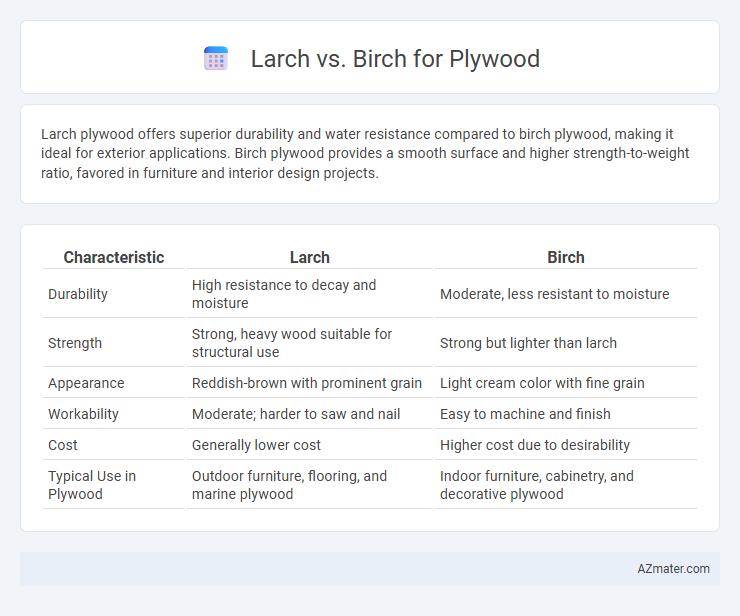Larch plywood offers superior durability and water resistance compared to birch plywood, making it ideal for exterior applications. Birch plywood provides a smooth surface and higher strength-to-weight ratio, favored in furniture and interior design projects.
Table of Comparison
| Characteristic | Larch | Birch |
|---|---|---|
| Durability | High resistance to decay and moisture | Moderate, less resistant to moisture |
| Strength | Strong, heavy wood suitable for structural use | Strong but lighter than larch |
| Appearance | Reddish-brown with prominent grain | Light cream color with fine grain |
| Workability | Moderate; harder to saw and nail | Easy to machine and finish |
| Cost | Generally lower cost | Higher cost due to desirability |
| Typical Use in Plywood | Outdoor furniture, flooring, and marine plywood | Indoor furniture, cabinetry, and decorative plywood |
Introduction to Larch and Birch Plywood
Larch plywood is valued for its durability, water resistance, and distinctive reddish-brown hue, making it ideal for exterior applications and marine use. Birch plywood offers a smooth surface, high strength, and excellent stability, favored in furniture making and interior cabinetry. Both species provide structural integrity, but Larch excels in moisture resistance while Birch is preferred for fine finish work.
Botanical Differences Between Larch and Birch
Larch (genus Larix) is a coniferous tree characterized by needle-like leaves and a resinous wood that is highly durable and resistant to moisture, making it suitable for exterior plywood applications. Birch (genus Betula) is a deciduous hardwood with broad leaves and a fine, uniform grain known for its smooth surface and strength, often used in interior plywood and decorative veneers. The botanical differences between needle-bearing larch and broadleaf birch influence the plywood's texture, strength, and resistance to environmental factors.
Physical Properties and Strength Comparison
Larch plywood exhibits superior strength and durability compared to birch, with higher density and excellent resistance to moisture and decay, making it ideal for outdoor and heavy-duty applications. Birch plywood offers a smoother surface and higher uniformity, providing better workability and a more aesthetically pleasing finish, suitable for interior furniture and cabinetry. When comparing hardness, larch scores higher on the Janka hardness scale, while birch provides moderate strength combined with better flexibility and resistance to warping.
Durability and Weather Resistance
Larch plywood is renowned for its high durability and excellent weather resistance due to its dense grain and natural resin content, making it ideal for outdoor applications. Birch plywood offers good strength and smooth surface finish but is less resistant to moisture and decay compared to larch, requiring additional treatment for prolonged exposure to harsh environments. Choosing larch plywood ensures longer lifespan and better performance in wet and fluctuating weather conditions.
Appearance and Grain Patterns
Larch plywood features a rich reddish-brown hue with prominent, straight grain patterns that create a warm and rustic aesthetic, making it ideal for decorative applications. Birch plywood exhibits a lighter, creamy color with fine, uniform grain patterns that provide a smooth and clean appearance, preferred for modern and minimalist designs. The contrast between larch's bold texture and birch's subtle elegance allows for versatile use based on visual preference in interior and furniture projects.
Workability and Machining Performance
Larch plywood offers excellent workability with good nailing, screwing, and gluing properties, making it suitable for various construction applications. Birch plywood exhibits superior machining performance due to its fine, even grain and hardness, allowing for clean cuts and smooth surface finishes with less tool wear. Both woods provide strong durability, but birch is preferred for precision machining and high-quality furniture manufacturing.
Cost and Availability
Larch plywood is generally more affordable due to the tree's faster growth and wider availability in Europe and North America, making it a cost-effective option for construction. Birch plywood offers higher density and durability but tends to be more expensive because of its limited supply and slower growth, primarily sourced from northern regions like Russia and Scandinavia. Availability for birch plywood can be inconsistent in some markets, whereas larch plywood is more widely accessible across different industries.
Environmental Impact and Sustainability
Larch plywood offers a higher durability and natural resistance to decay, reducing the need for chemical preservatives and extending product lifespan, which enhances its environmental sustainability. Birch plywood, sourced from fast-growing hardwood forests, promotes efficient reforestation efforts and carbon sequestration, contributing positively to sustainable forestry practices. Choosing either larch or birch plywood supports eco-friendly construction when sourced from certified sustainable plantations.
Typical Applications of Larch and Birch Plywood
Larch plywood is commonly used in exterior construction, marine environments, and outdoor furniture due to its excellent durability, water resistance, and natural resistance to decay. Birch plywood is preferred for interior applications such as cabinetry, furniture making, and decorative paneling because of its smooth surface, fine grain, and strong structural integrity. Both types offer high-quality veneers but differ in application based on environmental exposure and aesthetic requirements.
Choosing the Right Plywood: Larch vs Birch
Larch plywood offers superior durability and natural resistance to moisture and decay, making it ideal for exterior applications and projects requiring high structural strength. Birch plywood is valued for its smooth surface, fine grain, and consistent thickness, which makes it a preferred choice for furniture, cabinetry, and interior finishes where aesthetic appeal and precise machining are crucial. Comparing properties, larch plywood typically has higher density and strength, while birch plywood provides better veneer quality and a more uniform appearance, guiding selection based on project-specific demands.

Infographic: Larch vs Birch for Plywood
 azmater.com
azmater.com